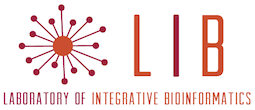Databases

Description: LeishDB is a public repository for genomic information from Leishmania species. Its current version stores information from protein coding genes and non-coding RNAs predicted in Leishmania braziliensis using updated algorithms and RNA-seq publicly available data
Website: www.leishdb.com
Torres, F; Arias-Carrasco, R; Caris-Maldonado, JC; Barral, A; Maracaja-Coutinho, V $; Queiroz, ATL. . LeishDB: a database of coding gene annotation and non-coding RNAs in Leishmania braziliensis. Submitted.
$ corresponding author

Description: The Non-coding RNA Databases Resource (NRDR) is a source of data related to more than 100 non-coding RNA (ncRNA) databases available over the internet. Our tool tries to represent an updated source for databases information retrieval. The goal is to facilitate researchers’ accessibility to ncRNA information freely available on public databases.
Website: www.ncrnadatabases.org
*Paschoal, AR; *Maracaja-Coutinho, V; Setubal, JC; Simões, ZLP; Verjovski-Almeida, S; Durham, AM. Non-coding transcripcion characterizaion and annotation: a guide and web resource for non-coding RNA databases. RNA Biology, 2012.
* Both authors contributed equally to this work.
Tools

Description: CEMiTool (Co-Expression Modules identification Tool) is a systems biology method that easily identifies co-expression gene modules in a fully automated manner.In addition to that, it also performs comprehensive modular analyses, such as: plotting the expression profile of individual genes on each module; determining the expression activity of modules in a group of samples; performing functional enrichment analysis of modules; and integrating co-expression results with protein-protein interaction data.
Website: http://cemitool.sysbio.tools/
Russo, PST; Ferreira, GR; Cardozo, LE; Bürger, MC; Arias-Carrasco, R; Maruyama, SR; Hirata, TDC; Lima, DS; Passos, FM; Fukutani, KF; Lever, M; Silva, JS; Maracaja-Coutinho, V; Nakaya, HI. CEMiTool: a Bioconductor package for performing comprehensive modular co-expression analyses. BMC Bioinformatics, 2018.

Description: StructRNAfinder predicts and annotates RNA families in transcript or genome sequences. This single tool not only displays the sequence/structural consensus alignments for each RNA family, according to Rfam database but also provides a taxonomic overview for each assigned functional RNA. Moreover, we implemented a user-friendly web service that allows researchers to upload their own nucleotide sequences in order to perform the whole analysis. The main advantage of StructRNAfinder relies on the large-scale processing and integrating the data obtained by each tool and database employed along the workflow, of which several files are generated and displayed in user-friendly reports, useful for downstream analyses and data exploration.
Website: http://structrnafinder.integrativebioinformatics.me
Arias-Carrasco, R; Vásquez-Morán, Y; Nakaya, HI; Maracaja-Coutinho, V. StructRNAfinder: an automated pipeline and web server for RNA families prediction. BMC Bioinformatics, 2018.
Description: CGIIS, an automated tool to close gaps inter and intra scaffolds, is a toolkit of Perl scripts to help the final steps of assembling whole genome sequencing projects. It generates a final dataset of super-scaffolds reconstructed based on similarity and genomic coordinates comparisons between the draft genome contigs/scaffolds, and additional sequencing runs or a related organism genome as a reference. The tool can also be used to join different assemblies of the same genome produced by distinct assembly tools.
Status: Under development
Description: miRQuest is a webserver that enables to the end-user a friendly and standardized way to use four different widely used ab initio tools for miRNA investigation. It can easily be used by biologists and researchers with limited programming skills in a web platform for miRNA research containing two main functions: (i) integration of different miRNA prediction tools for miRNA identification in a friendly environment; and (ii) the comparison among these prediction tools in order to select the best suitable approach to be applied in an organism of interest. In both cases the user only gives the FASTA sequences of interest as input to perform all analysis and comparisons.
Website: www.mirquest.integrativebioinformatics.me
Aguiar, RR; Ambrosio, LA; Sepúlveda-Hermosilla, G; Maracaja-Coutinho, V; Paschoal, AR. miRQuest: integrating tools in a web server for microRNA investigation. Genetics & Molecular Research, 2015.
MSGIP
Description: MSGIP – Mean Shift Genomic Island Predictor is an automated tool for the prediction of genomic islands based on mean shift algorithm. Genomic islands genomic regions acquired from other organisms by the phenomenon of horizontal transfer. MSGIP was developed in Java and is compatible with any operation system with Java Runtime Environment installed. The usage requires only a FASTA “.fna” file, containing the complete genomic sequence of the investigated bacteria.
Website: www.msgip.integrativebioinformatics.me
Drito, DM; Maracaja-Coutinho, V; Farias, ST; Batista, LV; Rego, TG. (2016). A novel method to predict genomic islands based on mean shift clustering algorithm. PLOS One, 2016.

Description: Dodo is a crowdfunding platform for Biotech and Life Sciences projects. We believe that crowdfunding is a powerful tool for funding interesting, but high risks projects, as well an alternative tool for science outreach.
Website: www.dodofunding.com

Description: A tool that merges, integrates and annotates a wide-range of gene expression data for better research using social networks, gamefication and citizen science.
Website: www.crowdnotation.org
Status: Under development


